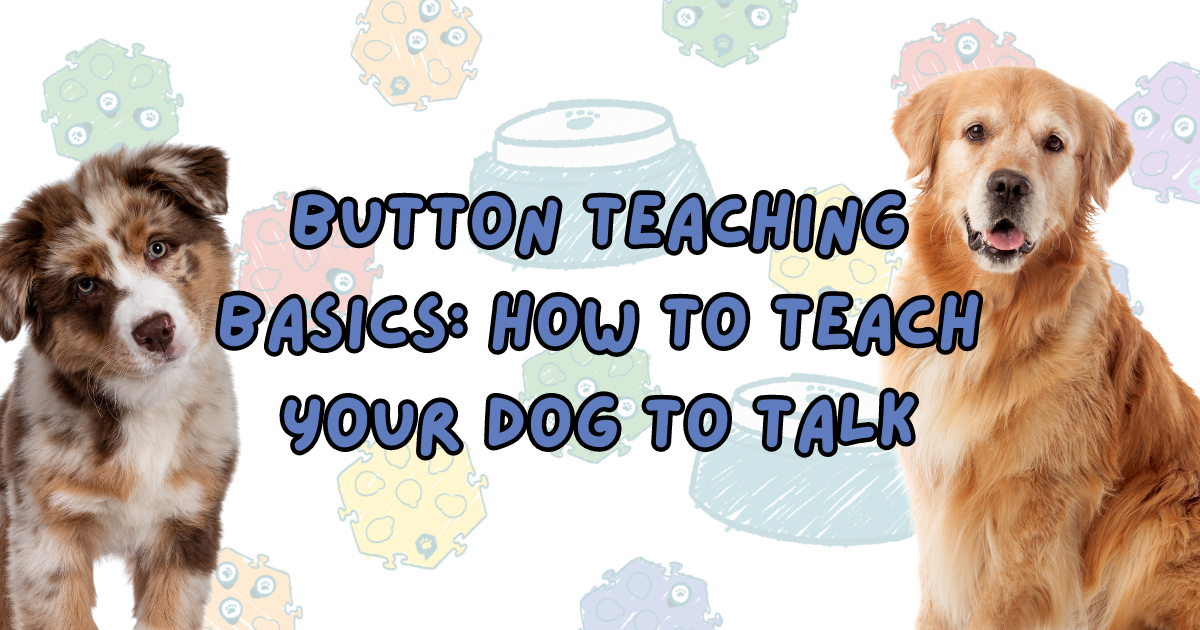Button Teaching Basics: How to Teach Your Dog to Talk
Have you ever looked at your dog and wished you knew what they were thinking or trying to tell you? Through the use of talking buttons, a form of Augmentative Interspecies Communication, we can connect with our dogs (and other animals) in ways never fully explored before. They are able to relay their thoughts, needs, and observations by pressing recordable buttons programmed with specific words. By providing our animals with a voice, we can better understand each other, giving everyone with a more fulfilling and rewarding life.
Understanding the Basics of Button Communication
Learner
Any animal you teach or plan to teach how to communicate with buttons. Ripley is our AIC learner.
Teacher
Any animal you teach or plan to teach how to communicate with buttons. Ripley is our AIC learner.
Soundboard
Composed of individual recordable buttons and textiles grouping like concepts, the soundboard acts as an auditory keyboard for learners to communicate with.
How Do They Learn?
We hope that the pending research from UCSD will tell us more about how and what’s happening with our dogs and buttons, but it seems that animals learn buttons primarily through narration (talking to them constantly), modeling (demonstration using the board), and reinforcement (doing the thing on the button when pressed). Some animals also benefit from target training on how to press buttons.
Getting Ready for Talking Buttons
Skeptics of AIC often state that button users ignore natural communication by using buttons. This couldn’t be further from the truth. One of the most important things you can do to effectively teach buttons is to focus on and build off of their natural and existing communication.
Spend time with your learner and pay closer attention.
What words and phrases of yours do they respond to?
What gets them excited? Nervous? Relaxed?
How do they try to communicate their needs? Do they bark, paw, whine?
What kinds of things do they try to communicate for?
Do they do things on a schedule?
How do they communicate with others (humans and animals) in the house?
When your learner communicates with you, communicate back.
We often ignore our dog’s whines or cries, but instead, thinking of each interaction as an opportunity to build trust and rapport can help increase (everyone’s) motivation.
Verbally talk to them AND use body language (nodding, head shaking, gesturing)
Get talking! Talk to your dog as much as you can using Learner Directed Speech.
Simplify your sentences - talk in baby speak.
Speak in a clear and enthusiastic tone
Repeat and emphasize the keyword 4-5x
Start Planning Your Soundboard
Plan your board’s location.
The board should be easily accessible. Your learner should be able to freely move around the board and access the buttons, ideally being able to look at you when using them.
Put the board in a spot where you and your family spend a lot of time
When choosing a location, consider future growth. Will you expand as your learner indicates, or will you stop at a certain number of words?
Plan your words and layout.
Choose your starting words (2-3 buttons). Starting words should motivate the learner, but healthy to model and reinforce repeatedly.
Loosely plan future words and map out your board. It’s thought that grouping like concepts together helps you and your learner to remember button positions and use the board quickly. You can always make adjustments to your plan as you go.
Check out our FREE Canva board template and AIC word list for inspiration and tools for getting started.
Ripley in front of his wall of buttons.
Introducing the First Buttons
So your buttons have arrived, and you’ve picked your location, layout, and your starting words. What do you do next?
Continue talking to your learner.
Never stop talking to your learner. Using Learner Directed Speech and emphasizing words you intend to or have already introduced can be helpful.
Model words as much as possible.
Modeling means demonstrating the meaning of a button for the learner or showing by example. This includes physically pressing the buttons and verbally stating the word out loud. This helps your learner to associate words/buttons to their meanings and learn the position of the board.
Prompt regularly, but don’t overprompt.
Prompting means attempting to get the learner to use the board by encouraging them to use it with a verbal cue or physical gesture. Common prompts include “What LEARNER NAME want?” and “Use your words.”
Introducing New Buttons
Every teacher introduces buttons differently. When we first started we put the board down and showed Ripley the buttons by pressing them. Now when introducing new words, we’ve found it helpful to hold the button in the palm of our hand or put it loose on the floor (not in a hextile) when first showing it to him. We then press the button (modeling) and let Ripley explore it. He usually presses it a bunch of times. After he’s seen us push the button and had an opportunity to do so himself, we put it on the board and show him the permanent position, modeling again. Some learners might not show interest in the new button like Ripley does. That’s okay too! Keep modeling. You’ll find what works best for your learner.
Things to Remember
Like Ripley, some learners take to buttons immediately. Others take weeks or months to show interest. Every learner is unique. Whatever camp your learner falls into, don’t give up. Staying persistent with talking to, modeling, and prompting your learner can make all the difference in their success. And remember, EVERY PRESS is a good press. Random button pressing is an opportunity to reinforce and teach what buttons mean. It can also mean your dog is exploring and learning the board. No success is too small to celebrate.




